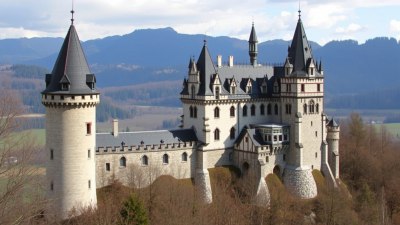Bran Castle in Romania No Longer Believes in Vampires
Explore how Bran Castle in Romania has shifted its focus away from vampire lore to embrace history.

Bran Castle, often dubbed as Dracula's Castle, has long been a cornerstone of vampire lore, capturing the imagination of tourists and horror enthusiasts around the globe. Situated near Bran, in Romania, its stunning Gothic architecture and dramatic history have made it a preferred destination for those intrigued by the tales of Count Dracula. However, in recent years, an intriguing shift has occurred in its narrative focus. The castle, which once reveled in its vampire association, has begun to move past the mythical creatures and delve deeper into its rich history and cultural significance.
This change is gathered around the desire to provide an authentic experience for visitors. Rather than presenting the myth of Dracula as the main attraction, Bran Castle now emphasizes its historical context, architecture, and connection to Romanian royalty. The castle was built in the 14th century and served a strategic military purpose, as well as a royal residence, and these stories offer a much richer tapestry for visitors to explore.
The Transformation of Bran Castle’s Image
The transformation began with an effort to rebrand Bran Castle, letting go of the chequered past of spookiness driven by literature and cinematic portrayals. Through this new narrative, Bran Castle aims to draw attention to its architectural beauty, historical significance, and the lifestyle of its past inhabitants. The museum that exists today showcases artifacts from Romania’s royal past, including furniture and personal belongings of Queen Marie, who played a significant role in the castle’s history.
Queen Marie, the last royal owner of Bran Castle, has become a central figure in its reimagined narrative. Her efforts to restore and maintain the castle in the early 20th century are highlighted, showing visitors the importance of the castle to Romanian national identity. This emphasis on Queen Marie and the actual history of the castle offers a more substantive understanding of the castle’s role in Romania’s past.
Transitioning from Myths to History
The pivot away from vampire myths is not just a marketing decision; it reflects a growing consciousness among cultural heritage sites worldwide regarding the authenticity of historical representation. Bran Castle joins numerous other heritage sites that are constantly reevaluating and reshaping narratives to enhance educational aspects of their history while remaining appealing to modern visitors.
For many years, the public's fascination with Count Dracula—a character born out of Bram Stoker’s novel—overshadowed the genuine historical significance of the castle. While legends concerning Count Dracula still attract visitors, the true narrative of Bran Castle encompasses stories of bravery, resilience, and royal intrigue that offer a more engaging story for an increasingly discerning audience.
The Role of Literature and Media
While the advent of Bram Stoker’s Dracula in 1897 laid the groundwork for Bran Castle's vampire legend, contemporary adaptations—be it films, novels, or TV series—have amassed a substantial following and further entrenched the vampire mythos in popular culture. This connection, while beneficial for tourism initially, eventually led to the castle being viewed more as a spectacle than a genuine historical site.
Increasingly, the management of Bran Castle recognizes the need to step back from purely fictional narratives and embrace the true history embedded in its walls. By offering guided tours that focus on actual events and occupants of the castle, visitors can delve into a far richer exploration of Romania’s rich heritage rather than merely focusing on the myths that have captured the imagination of countless generations.
Engaging the Next Generation
As Bran Castle adapts its narrative, it also recognizes the necessity of engaging younger generations that crave authenticity and educational value. Historical accuracy in museums and heritage sites is becoming more important than ever. By offering interactive exhibits, educational workshops, and guided historical tours, Bran Castle aims to educate the young visitors about Romania’s royal history, culture, and architectural beauty, negating the exaggerated vampire narratives.
Furthermore, educational programs can initiate discussions about the impact of literature and media on historical figures and perceptions. By examining the transformation of Bran Castle’s image, visitors—particularly students—have the opportunity to explore how myths can alter one’s understanding of history and cultural identity.
Challenges in Transitioning Narratives
Transitioning the narrative of a well-established landmark like Bran Castle comes with its challenges. While there is a pressing need to correct misconceptions and promote historical accuracy, rebranding heritage sites can sometimes alienate a segment of visitors who are primarily interested in tales of the macabre and fantasy. It is a fine balance to maintain between catering to those drawn by the romance of vampire lore while also appealing to history enthusiasts.
Additionally, there is a risk that the allure that originally drew millions to Bran Castle may wane without connections to the Dracula mythos. To address this, the castle management has been incorporating elements of the legend in a way that complements rather than dominates the historical narrative, making it clear that the truth is often more fascinating than fiction.
Bran Castle Today
Today, Bran Castle stands as a testament to both historical and cultural richness, offering a well-rounded experience that enlightens visitors about its actual past while paying homage to the vampire legends that have made it famous. Engaging exhibits, guided tours focusing on its royal heritage, and educational programs set the stage for a transformative visit that can appeal to a diverse audience. By fostering a deeper appreciation for its architectural grandeur and historical narratives, Bran Castle seeks to reshape its legacy.
As tourist interest evolves, Bran Castle’s management continues to explore ways to expand its focus, ensuring that it remains relevant and appealing to a broad audience while shedding light on its historical importance. This delicate interplay between myth and reality is crucial in securing the castle's place as both a cultural landmark and a beacon for those seeking historical insights.
The Future of Bran Castle
Moving forward, examining Bran Castle's impact on tourism and cultural heritage emphasizes the vital role that heritage sites play in informing and shaping national identity. As the castle continues to reshape its narrative, it also encourages a broader conversation about the world of myth-making and how history is often intertwined with fiction. The challenge is not just to celebrate legends but to integrate them responsibly within the framework of historical truth.
As global travel continues to evolve, Bran Castle is ideally positioned to become a leader in redefining how historical sites can convey authentic stories while retaining an element of intrigue. This reclamation of its identity represents a significant shift in how the surrounding community can leverage its history, supporting local economies while promoting a genuine appreciation for Romania's rich heritage.
Bran Castle, therefore, stands as a symbol of change, evolution, and the underlying strength of Romania's royal history. By moving beyond the vampire lore that once defined it, the castle is set to flourish in a new era of cultural tourism, one that genuinely reflects the historical narratives that deserve to be shared and celebrated.











